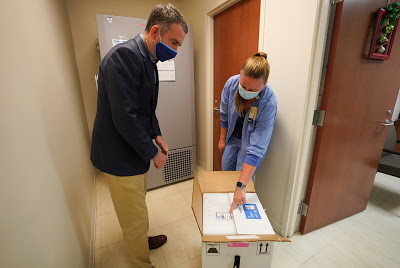Virginia healthcare workers start getting COVID vaccines
 |
| Yolanda Dumas, an emergency room nurse at Sentara Healthcare in Norfolk got the first COVID-19 vaccine in Virginia. |
Virginia received its first shipment of COVID-19 vaccines and began inoculating healthcare workers yesterday.
Supplies are limited, so high-risk groups will be vaccinated first. The state’s initial shipment included 72,150 doses and is targeted to healthcare workers. “By early to mid-summer, everyone will have access to the vaccine,” said Gov. Ralph Northam at a virtual community conversation Dec. 15.
The next group to get vaccinated, in Phase 1A, will be staff and residents of long-term healthcare facilities. Essential workers will be in Phase 1B, including people working with food and transportation. Phase IC consists of people 65 and over and adults with underlying conditions that put them at risk for bad outcomes from COVID.
 |
| Gov. Ralph Northam welcomes one of the first shipments of the Pfizer-BioNTech COVID-19 vaccine to a Bon Secours hospital in Richmond Dec. 14. |
Phases 2 and 3 call for vaccinating the general public. At that point, “herd immunity” will be reached, meaning the pool of people infected will be greatly reduced.
The vaccines will be 100 percent free for everyone. There will be no out-of-pocket costs. Insurance companies might be charged for administering the vaccine, but if that’s not possible, the federal government will reimburse healthcare providers.
With the vaccine, “we see hope; we see a light at the end of a very long and dark tunnel,” Northam said.
COVID surging
While the vaccine is certainly a big step in getting to the end of the pandemic, Northam said, there’s some concerning news, too. There were more than 3,000 new cases and 56 additional deaths in Virginia on Dec. 15, and the positivity rate is going up.
There are now three times as many new cases daily as there were during the surge in April and May, added Virginia Health Commissioner Dr. Norman Oliver.
“The virus will be with us for several months,” Northam said. “We need to do everything we can to keep the curve flat.” And that means everyone needs to continue to wear masks, practice social distancing, and wash hands frequently – they have been vaccinated.
A focus on equity
The Dec. 15 community conversation was targeted to African American leaders and residents. The Virginia Health Department is also hosting community conversations for other population groups.
The concerns and questions raised during these sessions will help state officials craft the right messages for community and faith leaders to ensure their followers understand the importance of getting vaccinated.
It’s also critical to ensure community members get information from trusted sources, such as the CDC, Virginia Health Department, and healthcare providers. There’s a lot of inaccurate information out there, and there are already a lot of vaccine scams going on targeting the Black and Latino communities, said Janice Underwood, Virginia’s chief diversity, equity, and inclusion officer.
State officials assured participants at the Dec. 15 session that the vaccine rollout is being done with an eye toward equity.
“The virus has exposed long-standing health equity issues,” said Underwood. Hispanics have the highest rate of COVID infections, while African Americans have the highest death rate.
One reason why those populations are so hard hit by COVID is that they are disproportionately represented among essential workers. They are also subject to inequities in healthcare and socioeconomic conditions that put them at risk of chronic disease.
Safe and effective
Both the Pfizer and Moderna vaccines are 95 percent effective. According to Oliver, the 5 percent of people in the clinical trials who got COVID after having the vaccine had mild symptoms.
Related story: Virginia Gov. Northam imposes new restrictions in response to COVID surge
The people in the trials continue to be monitored for side effects. The most common side effects are pain at the injection site, short-lived fever, and headaches, said Dr. Stephanie Wheawill, director of pharmacy services in the Health Department’s office of epidemiology.
The only people who had adverse reactions are people who have had anaphylactic reactions to previous vaccines, Wheawill said.
The clinical trials include people with underlying health conditions and people from diverse backgrounds. The data found no evidence that certain populations are more likely to have adverse reactions, Oliver said.
Both vaccines require two doses, and it’s really important that the second dose is from the same manufacturer as the first. The first dose will provide 50 percent immunity; you need the second dose to get to 95 percent. The Pfizer doses are given 21 days apart; the Moderna doses 28 days apart.
Modern vaccines are different from ones developed decades ago, Oliver said. Scientists knew the genetic makeup of the virus in January and researchers spent the last 11 months developing the vaccine and conducting three phases of clinical trials involving 75,000 people to determine whether the vaccines are safe and effective.
The vaccines use Messenger RNA (mRNA), a synthetic genetic sequence that contains instructions for cells to make COVID-19 protein without causing the disease. The vaccines do not contain the virus.
People who have had COVID aren’t likely to get reinfected within three months. So Wheawill advises people who have the virus to wait three months before getting the vaccine.
After being vaccinated, people are encouraged to check in with the CDC’s v-safe app to report any problems and get a reminder about the second dose.

